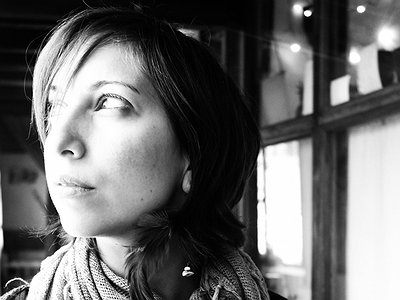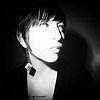Part 1
Name: Sol Rezza
Nationality: Argentina
Occupation: Sound Artist
Projects: "In The Darkness of The World"for the CTM Festival in Berlin / Storm/S to be broadcasted live for the World Listening Day 2015
Musical Recommendations: Olivia Louvel is quite a remarkable artist, her work with voice and electronics is something worth having as a travelling experience. Maja S. K. Ratkje is another artist no one should be missing.
When did you start writing/producing music - and what or who were your early passions and influences?
Radio. Radio was there since I was a child; I remember times when I was just a kid and I just sat and listened to the radio, in full attention. So the first thing I did when I finished my formal education was to go ask for an internship with one of the DJs I grew up listening to. There, I truly started to learn the craftsmanship, and then I studied radio production. Nonetheless I soon realized that what people usually understand as “radio” was not what I truly liked about such media. And that was the possibility of conjuring worlds, telling stories through the sounds. So I started to play with the radio craft and with the sounds to develop my own concept.
For most artists, originality is first preceded by a phase of learning and, often, emulating others. What was this like for you? How would you describe your own development as an artist and the transition towards your own voice?
Someone once told me that a person is constructed by infinite threads, like a huge tapestry filled with details. I think there were touchstones in my life that definitively shaped the way I work.
When I finished studying radio I decided with some friends, to go out and travel through Argentina with an itinerant radio; so we visited Catamarca, a province in the Argentinean northwest where indigenous culture remains alive and strong. There we found these women that cultivate a kind of singing called vidala. Vidala is accompanied by a percussion instrument called “caja” or by guitars; it has musical forms of a very peculiar and antique nature. This kind of chanting and the overlapping of voices they practice had a strong influence on me. Oddly enough, and on the other hand, the study of the Italian and the Russian Futurist Movements had a strong influence on me; Marinetti and his “Letter from the Trenches” was a marvellous discovery. I think the reason why I feel so influenced by both is because they proved to me that anything could be told by means of the sound without the use of any word.
Later I found the work of amazing women like Delia Derbyshire and her radiophonic and electronic constructions, or Meredith Monk and Joan La Barbara with their voice techniques; or males like Peter Brook and his ideas about the mise en scène, the paths to tell stories and how that relates with the body. All of them take part in that tapestry I am today.
Also, the Nahuatl culture from Mexico, the place where I live, and the soundscapes that surround me are of great influence in my work.
What were your main compositional- and production-challenges in the beginning and how have they changed over time?
My work “25 Segundos de Vida” (25 Seconds of Life, 2009) was my first grand challenge. The combination of voice and text was a milestone for the way I compose with sounds. That piece raised the main personal questions about language, idiom, sound of the voice and narrative. Another very challenging work was “Verdades Minúsculas” (Tiny Truths, 2011), because it was my first strictly musical work.
My last work “In The Darkness Of The World” was a huge challenge specially because of how it was constructed. It was meant to adapt to three different media (live performance, radio and Internet) without losing its narrative and its sonic structure. Each media had its own particularities: the live performance was a surround construct; the radio version was a stereo composition; and finally, the internet version became an audiovisual piece in collaboration with the video artist Daniel Iván, whom produced beautiful visuals for it.
Keeping the sound narrative without losing control and perspective of the requirements of each media and of the work as a whole was truly demanding. The listener can experience a single narrative from several forms of listening and that is a new milestone in the development of my work.
Tell us about your studio, please. What were criteria when setting it up and how does this environment influence the creative process? How important, relatively speaking, are factors like mood, ergonomics, haptics and technology for you?
My studio is located in a beautiful town in Mexico, called Valle de Bravo. It is small and quiet, and surrounded by cats and nature. It is a quiet place to think and compose. One of the things that has a massive influence on my work is the light that enters from one of my windows and the way it changes throughout the day. It shows me that time is passing by but in a very different way than a clock could display.
When it comes to the technology aspect I like to work with just a few elements: a sound card, a midi controller, a field recorder, microphones and my computer. I am truly interested in the tech side of my work, and I try to be informed about the last mainstream advances or the independent developments in hardware and software. Nonetheless, they are instruments to reach a goal, not a goal by themselves. I am not truly interested in having the latest microphone on the market; I am interested in acknowledging its existence and in studying its properties, and in using that knowledge to make the most of the instruments I do have.
What are currently some of the most important tools and instruments you're using? In which way do certain production tools suggest certain approaches, in which way do they limit and/or expand your own creativity? How do you see the role of sound designers and software programmers in the creative process?
I am a sound engineer and sound designer; so the most important tools to me are those I need at the moment in relation with what I intend to say; and that can be either a midi controller or a balloon filled with water.
Maybe my main technological instruments are a field recording device and a good set of headphones. But they are only accessories to my ears. My main instruments are my ears.
I feel closer to sound design than to musical composition. I think the approach to sound is radically different; the treatment of the sound is different. I feel currently very attracted, for example, to the sound design for video games, because in such an arena you get to create an immersive environment under very strict rules and you must do it by taking into account parameters like the computer’s memory, different platforms, and so on; and it is team work in which you must connect with the programmer. It is a very appealing environment to experiment.
Software programmers are a core part for me in the current media art scene. It is like watching a painting: if it is properly framed, it is strong and coherent; a poorly framed painting loses much of its form and message. To me a software programmer is an artist of the framing. I realized that while working with Daz Disley in “In The Darkness Of The World”, he is some kind of a mad scientist of programming for the arts, and his sound ideas are pretty unique.
Many contemporary production tools already take over significant parts of what would formerly have constituted compositional work. How has this affected your own production process and its results? Are there any promising solutions or set-ups capable of triggering new ideas inside of you as a composer?
I think the most powerful tool we have as composers is the possibility of questioning. Inquiring, what can I do with what I have at hand? How can I use it? Departing from such questions you have a broader scheme of possibilities: a simple bone, a synth or an app can be useful tools for composing.
During the last Game Development Conference in San Francisco there was a lot of talking going on about the new virtual reality devices, and a lot of discussions about the changes in the forms of perception for the gamers and about how these new technologies will change the ways of listening. Analysis of these possibilities and of the questions that arise are a definitive trigger when I think about composition; not the devices by themselves but the analysis of how our perception is changed through technological changes.
Could you describe your creative process on the basis of a piece or album that's particularly dear to you, please? Where do ideas come from, what do you start with and how do you go about shaping these ideas?
Ideas are all around; you don’t choose a story, it chooses you for some reason. It may sound stupid but it happens to me all the time. There’s suddenly this idea in my mind and I cannot find any sort of peace until I sit, take care of it, and try to understand it and to, somehow, bring something out of it.
It happened to me with “In The Darkness Of The World”. It was an idea surrounding me for eight years; eight years ago I read the book “Twenty Thousand Leagues Under the Sea” by Jules Verne and left the book, abandoned in an airport in Colombia; I materialized all the sound images I got from that book up to this year.
When I was working on “32 Turbulencias” (32 Turbulences, 2013) it was the sudden attack of very vivid images from my childhood, specially from books I read during my childhood, that took me to spend a year reading nothing but children’s books and getting lost in the illustrations.
Stories and ideas inhabit our bodies for a while and then just fade to leave room for new ones to come.






